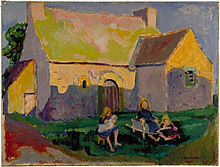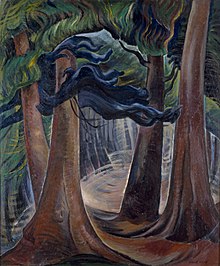Emily Carr
Emily Carr (December 13, 1871 – March 2, 1945) was a Canadian artist who was inspired by the monumental art and villages of the First Nations and the landscapes of British Columbia.
[14][15] The Carr home was on Birdcage Walk (now Government Street), in the James Bay district of Victoria, a short distance from the legislative buildings (nicknamed the 'Birdcages') and the town itself.
Her father believed it was sensible to live on Vancouver Island, a colony of Great Britain, where he could practice English customs and continue his British citizenship.
[22] In 1907, Carr made a sightseeing trip to Alaska with her sister Alice and decided on her artistic mission of documenting all she could of what she and many others perceived as the "vanishing totems" and way of life of the First Nations.
Determined to further her knowledge of evolving artistic trends abroad, in 1910 Carr returned to Europe to study.
In Montparnasse with her sister Alice, Emily Carr met modernist painter Harry Phelan Gibb with a letter of introduction.
[25] Upon viewing his work, she and her sister were shocked and intrigued[26] by his use of distortion and vibrant colour; she wrote:"Mr Gibb's landscapes and still life delighted me — brilliant, luscious, clean.
"[25]Carr enrolled at the Académie Colarossi in Paris, then transferred to private lessons with John Duncan Fergusson and followed him to the Atelier Blanche.
[27] In Crecy-en-Brie she fully embraced the Fauve style of bold colour and broad brushwork, then traveled to Concarneau on the coast of Brittany to study with Frances Hodgkins.
She organized an exhibition of seventy watercolours and oils representative of her time in France, using her radical new style, bold colour palette and lack of detail.
Tanoo, another painting inspired by work gathered on this trip, depicts three totems before house fronts at the village of the same name.
She gave a detailed public talk titled "Lecture on Totem Poles" about the Aboriginal villages that she had visited, which ended with her mission statement: "I glory in our wonderful west and I hope to leave behind me some of the relics of its first primitive greatness.
Carr made the trip east for the exhibition on West Coast art: Native and modern at the National Gallery of Canada in 1927.
She met Frederick Varley in Vancouver and other members of the Group of Seven, at that time Canada's most recognized modern painters[18] at the show's Toronto venue.
[24] Her encounter with the Group ended the artistic isolation of Carr's previous 15 years, leading to one of her most prolific periods, and the creation of many of her most notable works.
She jettisoned her painterly and practiced Post-Impressionist style in favour of creating highly stylized and abstracted geometric forms.
One of her last trips north was in the summer of 1928, when she visited the Nass and Skeena rivers, as well as Haida Gwaii, formerly known as the Queen Charlotte Islands.
[4] In the same year she bought a caravan she nicknamed the "Elephant" and had it towed to places she wanted to paint, going to nearby locations such as Goldstream Flats, the Esquimalt Lagoon and elsewhere.
[4] Paintings from Carr's last decade reveal her growing anxiety about the environmental impact of industry on British Columbia's landscape.
Her work from this time reflected her growing concern over industrial logging, its ecological effects and its encroachment on the lives of Indigenous people.
In her painting Odds and Ends, from 1939 "the cleared land and tree stumps shift the focus from the majestic forestscapes that lured European and American tourists to the West Coast to reveal instead the impact of deforestation.
Carr's main themes in her mature work were the monumental works of the First Nations and nature: "native totem poles set in deep forest locations or sites of abandoned native villages" and, later, "the large rhythms of Western forests, driftwood-tossed beaches and expansive skies".
Her "qualities of painterly skill and vision [...] enabled her to give form to a Pacific mythos that was so carefully distilled in her imagination".
[50] Her painting can be divided into several distinct phases: her early work, before her studies in Paris; her early paintings under the Fauvist influence of her time in Paris; a Post Impressionist middle period[32] before her encounter with the Group of Seven; and her later, formal period, under the cubist and post-cubist influences of Lawren Harris and American artist and friend, Mark Tobey.
Her painting Old Time Coast Village (1929–30) is referred to in Korean Canadian artist Jin-me Yoon's A Group of Sixty-Seven (1996).
[6] As well as being "an artist of stunning originality and strength", she was an exceptionally late bloomer, starting the work for which she is best known at the age of 57 (see Grandma Moses).
[6] Emily Carr brought the north to the south; the west to the east; glimpses of the ancient culture of the Indigenous peoples of the Americas to the most newly arrived Europeans on the continent.
[81] In 1952, works by Emily Carr along with those of David Milne, Goodridge Roberts and Alfred Pellan represented Canada at the Venice Biennale.
[87] On November 28, 2013, one of Carr's paintings, The Crazy Stair (The Crooked Staircase), sold for $3.39 million at Heffel's live auction in Toronto.
[104] Library and Archives Canada also holds a number of other fonds containing material that touch on Emily Carr and her artistic works.











